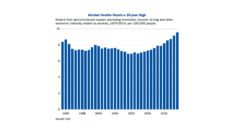In our recent study, we examined the presence of alcohol among 27,000 homicide victims across 17 states during the decade 2003 to 2012. We found that restrictive state policies regarding alcohol distribution and consumption were associated with lower levels of alcohol involvement among persons who were murdered.
The data was extracted from the National Violent Death Reporting System of the Centers for Disease Control and Prevention. Our measure of a state’s “alcohol policy environment” was based on an index of 29 concurrent alcohol control policies, such as alcohol taxation, retail restrictions, and licensing regulation, which characterizes the stringency of alcohol control policies. Alcohol involvement of the victim was determined by whether his or her level of alcohol had reached legal limit of 0.08, a level that is indicative of acute intoxication.
A one percentage point increase in the restrictiveness of the state policy index was associated with about a one percent lower chance of being intoxicated at the time of death.
Specifically, we found that a one percentage point increase in the restrictiveness of the state policy index was associated with about a one percent lower chance of being intoxicated at the time of death. The protective effect of strict policies was found among key vulnerable subpopulations such as young adult victims, and those who died from firearms-related homicides.
Acute intoxication impairs judgment and makes individuals more vulnerable to becoming victims in homicides. Although our study did not contain information about alcohol involvement among the perpetrators, our findings suggest a potentially protective impact of more restrictive alcohol policies in preventing homicide victimization by reducing alcohol involvement among those who may become victims.
Feature image: Jeff Drongowski, Untitled, used under CC BY 2.0













